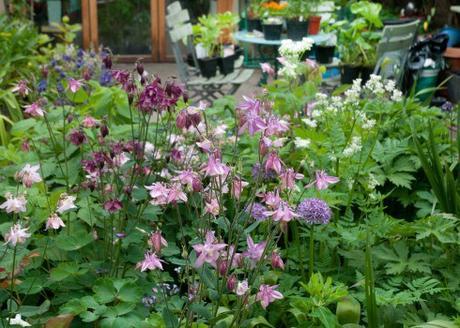 These gorgeous Aquilegias (aka columbines, Granny’s bonnets) seemed to have exuberantly increased since last year (all on their own), and post spring bulbs, have joyfully created the next wave of interest in my back garden. These are the common Aquilegia vulgaris, readily morphing into all shades of pink, purples and whites, and although you can find many fancy and rather tempting hybrids to buy, these cottage garden favourites retain their appeal partly due to their simplicity and also to the fact that they can pop up in cracks in paving and in spots all over the garden.
These gorgeous Aquilegias (aka columbines, Granny’s bonnets) seemed to have exuberantly increased since last year (all on their own), and post spring bulbs, have joyfully created the next wave of interest in my back garden. These are the common Aquilegia vulgaris, readily morphing into all shades of pink, purples and whites, and although you can find many fancy and rather tempting hybrids to buy, these cottage garden favourites retain their appeal partly due to their simplicity and also to the fact that they can pop up in cracks in paving and in spots all over the garden. 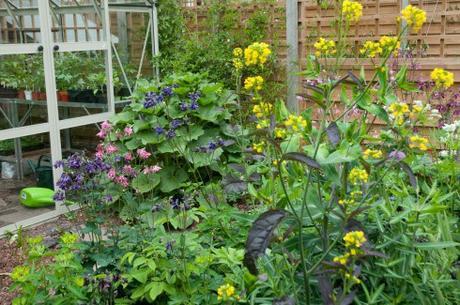 Giant red Mustard leaf is another welcome self-seeder and its deep purple leaf and bright yellow flowers have added a zing to an otherwise tasteful but rather pastel color palette right now in this border. The groovy Caper Spurge (Euphorbia lathyris) just to the right of the mustard leaf has also plonked itself right at the front of the bed, but it’s an airy plant with a wonderful texture and a wild upside down alien-like tripod structure which always adds a richness to the planting. I think I dug one up from my parents garden over 15 years ago and it appears all over the garden in different positions every year. In summer I can actually hear the seed casings popping as another seed is ejected and flung into the garden. I love it!
Giant red Mustard leaf is another welcome self-seeder and its deep purple leaf and bright yellow flowers have added a zing to an otherwise tasteful but rather pastel color palette right now in this border. The groovy Caper Spurge (Euphorbia lathyris) just to the right of the mustard leaf has also plonked itself right at the front of the bed, but it’s an airy plant with a wonderful texture and a wild upside down alien-like tripod structure which always adds a richness to the planting. I think I dug one up from my parents garden over 15 years ago and it appears all over the garden in different positions every year. In summer I can actually hear the seed casings popping as another seed is ejected and flung into the garden. I love it! 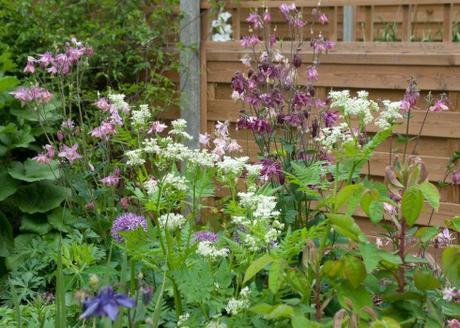 Umbel-like Sweet Cicely flowers have joined the throng of pinks and purples, alongside globes of Allium purple sensation,
Umbel-like Sweet Cicely flowers have joined the throng of pinks and purples, alongside globes of Allium purple sensation,  and I’m pleased to see Phloxes, Roses, Geranium psilostemon (above) and Sisyrinchium coming along too so that they’ll be continued color in the border once the Aquilegias have gone over.
and I’m pleased to see Phloxes, Roses, Geranium psilostemon (above) and Sisyrinchium coming along too so that they’ll be continued color in the border once the Aquilegias have gone over. 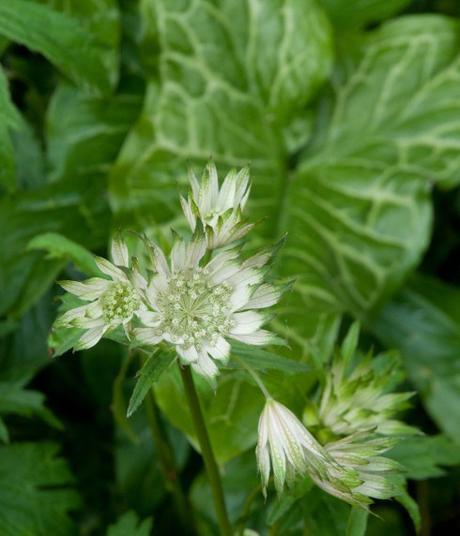 In a shadier spot, Astrantia (‘Shaggy’ I think) looks great with the self-seeded (and a tad thuggish if you let it) Arum italicum as a backdrop, and I can see a couple of teasels (Dipsacus fullonum) popping up too to give height and drama to these areas for summer too.
In a shadier spot, Astrantia (‘Shaggy’ I think) looks great with the self-seeded (and a tad thuggish if you let it) Arum italicum as a backdrop, and I can see a couple of teasels (Dipsacus fullonum) popping up too to give height and drama to these areas for summer too. 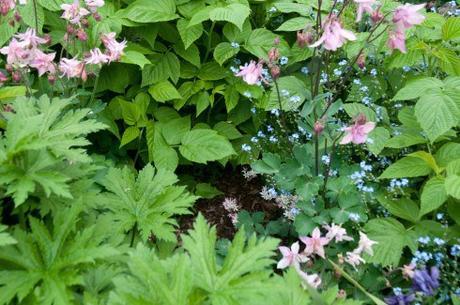 Just one noticeable gap in the bed where I divided a Verbena ‘Bampton’ , left it kicking around in an old compost bag for weeks before replanting a bit later in the year and not surprisingly, (but disappointingly) it’s not returned this spring. Bit of a shame as it was a lovely mid-height variety with pink flowers, but it looks like the raspberries will colonize this spot as the season moves on, again, without much interference on my behalf. Not quite what I’d planned, but great when nature will fill in the gaps for you.
Just one noticeable gap in the bed where I divided a Verbena ‘Bampton’ , left it kicking around in an old compost bag for weeks before replanting a bit later in the year and not surprisingly, (but disappointingly) it’s not returned this spring. Bit of a shame as it was a lovely mid-height variety with pink flowers, but it looks like the raspberries will colonize this spot as the season moves on, again, without much interference on my behalf. Not quite what I’d planned, but great when nature will fill in the gaps for you.
P.s. If you’re having problems with your Aquilegias this year, you’re not alone. Read this Telegraph article from earlier in the year about a killer Aquilegia mildew and how best to deal with it.
